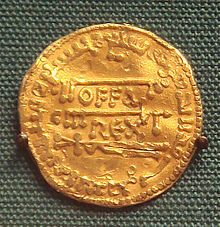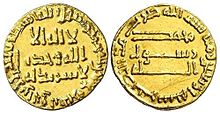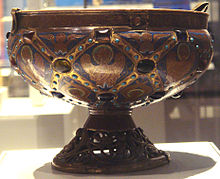A | B | C | D | E | F | G | H | CH | I | J | K | L | M | N | O | P | Q | R | S | T | U | V | W | X | Y | Z | 0 | 1 | 2 | 3 | 4 | 5 | 6 | 7 | 8 | 9
Right image: at the top, detail of the Virgin's mantle hem in Antonio Vivarini's Saint Louis de Toulouse, 1450. At the bottom, detail of Virgin's mantle hem in Jacopo Bellini's Virgin of Humility, 1440. Louvre Museum.
Pseudo-Kufic, or Kufesque, also sometimes pseudo-Arabic,[1] is a style of decoration used during the Middle Ages and the Renaissance,[2] consisting of imitations of the Arabic script, especially Kufic, made in a non-Arabic context: "Imitations of Arabic in European art are often described as pseudo-Kufic, borrowing the term for an Arabic script that emphasizes straight and angular strokes, and is most commonly used in Islamic architectural decoration".[3] Pseudo-Kufic appears especially often in Renaissance art in depictions of people from the Holy Land, particularly the Virgin Mary. It is an example of Islamic influences on Western art.
Early examples

Abbasid Dinar for comparison:



Some of the first imitations of the Kufic script go back to the 8th century when the English King Offa (r. 757–796) produced gold coins imitating Islamic dinars. These coins were copies of an Abbasid dinar struck in 774 by Caliph Al-Mansur, with "Offa Rex" centred on the reverse. It is clear that the moneyer had no understanding of Arabic as the Arabic text contains many errors. The coin may have been produced in order to trade with Al-Andalus; or it may be part of the annual payment of 365 mancuses that Offa promised to Rome.[4]
In Medieval southern Italy (in merchant cities such as Amalfi and Salerno) from the mid-10th century, imitations of Arabic coins, called tarì, were widespread but only used illegible pseudo-Kufic script.[5][6][7]
Medieval Iberia was especially rich in architectural decorations featuring both pseudo-Kufic and pseudo-Arabic designs,[2] largely because of the presence of Islamic states on the peninsula. The Iglesia de San Román (consecrated in 1221) in Toledo included both (real) Latin and pseudo-Arabic (i.e., not Kufic style) inscriptions as decorative elements. The additions of Pedro I of Castile and León to the Alcazar of Seville (mid-14th century) bear pseudo-Kufic design elements reminiscent of the Alhambra in Granada, and the metal facade of the main doors to the Cathedral of Seville (completed 1506) include arabesque and pseudo-Kufic design elements. Such decorative elements addressed both social realities and aesthetic tastes: The presence of many Arabized Christians in many of these otherwise Christian states, and a general appreciation among the Christian aristocracy for Islamic high culture of the time.
Examples are known of the incorporation of Kufic script and Islamic-inspired colourful diamond-shaped designs such as a 13th French Limoges enamel ciborium at the British Museum.[8] The band in pseudo-Kufic script "was a recurrent ornamental feature in Limoges and had long been adopted in Aquitaine".[9]
-
Pseudo-Arabic (i.e. not Kufic style) surrounding an interior window of the Church of San Román, Toledo, Spain (c. 1221)
-
Decoration from a wall in the Alcázar of Seville (c. 1350), showing a band of pseudo-Kufic decoration meant to mimic decorations in the Alhambra
-
Part of the metal facade on the main door to the Cathedral of Seville (c. 1500), showing both arabesque and pseudo-Kufic design elements
Renaissance painting
| Part of a series on |
| Arabic culture |
|---|
 |
Numerous instances of pseudo-Kufic are known from European art from around the 10th to the 15th century. Pseudo-Kufic inscriptions were often used as decorative bands in the architecture of Byzantine Greece from the mid 11th century to mid-12th century, and in decorative bands around religious scenes in French and German wall paintings from the mid-12th to mid-13th century, as well as in contemporary manuscript illuminations.[10] Pseudo-Kufic would also be used as writing or as decorative elements in textiles, religious halos or frames.[11] Many are visible in the paintings of Giotto (c. 1267 – 1337).[3]
From 1300 to 1600, according to Rosamond Mack, the Italian imitations of Arabic script tend to rely on cursive Arabic rather than Kufic, and therefore should better be designated by the more generalist term of "pseudo-Arabic".[3] The habit of representing gilt halos decorated with pseudo-Kufic script seems to have disappeared in 1350, but was revived around 1420 with the work of painters such as Gentile da Fabriano, who was probably responding to artistic influence in Florence, or Masaccio, who was influenced by Gentile, although his own script was "jagged and clumsy", as well as Giovanni Toscani or Fra Angelico, in a more Gothic style.[12]
From around 1450, northern Italian artists also started to incorporate pseudo-Islamic decorative devices in their paintings. Francesco Squarcione started the trend in 1455, and he was soon followed by his main pupil, Andrea Mantegna. In the 1456–1459 San Zeno Altarpiece, Mantegna combines pseudo-Islamic script in halos and garment hems (see detail), to depiction of Mamluk book-bindings in the hand of San Zeno (see detail), and even to a Turkish carpet at the feet of the Virgin Mary (see detail).[13]
The exact reason for the incorporation of pseudo-Kufic or pseudo-Arabic in Medieval or early Renaissance painting is unclear. It seems that Westerners mistakenly associated 13-14th century Middle-Eastern scripts as being identical with the scripts current during Jesus's time, and thus found natural to represent early Christians in association with them:[14] "In Renaissance art, pseudo-Kufic script was used to decorate the costumes of Old Testament heroes like David".[15] Another reason might be that artist wished to express a cultural universality for the Christian faith, by blending together various written languages, at a time when the church had strong international ambitions.[16]
Pseudo-Hebrew is also sometimes seen,[17] as in the mosaics at the back of the apse and the base of the dome in Marco Marziale's Circumcision, which do not use actual Hebrew characters.[18] It was especially common in German works.
Finally pseudo-Arabic elements became rare after the second decade of the 16th century.[19] According to Rosamond Mack: "The Eastern scripts, garments, and halos disappeared when the Italians viewed the Early Christian era in an antique Roman context."[19]
-
Pseudo-Kufic on the veil of the Virgin, Ugolino di Nerio, c. 1315–1320
-
Pseudo-Kufic mantle hem, in Paolo Veneziano's Virgin Mary and Child, 1358. Louvre Museum
-
Pseudo-Arabic script in the Virgin Mary's halo, detail of Adoration of the Magi (1423) by Gentile da Fabriano. The script is further divided by rosettes like those on Mamluk dishes.[20]
-
Pseudo-Arabic on the Christ Child's blanket, by Gentile da Fabriano[22]
-
Virgin with a Gothicizing pseudo-Arabic halo, by Fra Angelico (c. 1428–1430)
-
The Virgin Mary in Andrea Mantegna's San Zeno Altarpiece combines pseudo-Arabic halos and garment hems, with a Turkish carpet at her feet (c. 1456–1459).
Gallery
-
Pseudo-Kufic on garments in Henri Bellechose's Le Retable de Saint Denis, c. 1415–1416
-
Virgin of Humility, adored by a prince of the House of Este by Jacopo Bellini, 1440, with pseudo-Kufic mantle hem, but halo in Roman script. Louvre Museum
-
Pseudo-Kufic halo, in Antonio Vivarini's Saint Louis de Toulouse, 1450. Louvre Museum
-
Pseudo-Kufic hem in Giovanni Bellini's Le Christ Bénissant, c. 1465–1470. Louvre Museum
-
Early-16th-century Andalusian dish with pseudo-Arabic script around the edge, excavated in London. Museum of London
See also
- Pseudo-Hebrew
- Asemic writing – Wordless open semantic form of writing
- Islamic contributions to Medieval Europe
- Islamic influences on Christian art
- Oriental carpets in Renaissance painting
- Mongol elements in Western medieval art
Notes
- ^ Robbert Woltering (2011), "Pseudo-Arabic", in Lutz Edzard and Rudolf de Jong (eds.), Encyclopedia of Arabic Language and Linguistics (Brill), consulted online on 14 October 2023.
- ^ a b Encyclopaedia Britannica. Beautiful Gibberish: Fake Arabic in Medieval and Renaissance Art
- ^ a b c Mack, p.51
- ^ Medieval European Coinage by Philip Grierson p.330
- ^ Cardini, p.26
- ^ Grierson, p.3
- ^ Matthew, p.240
- ^ British Museum exhibit
- ^ a b Louvre museum notice Archived 2011-06-15 at the Wayback Machine
- ^ Mack, p.68
- ^ "Beautiful Gibberish: Fake Arabic in Medieval and Renaissance Art". Encyclopedia Britannica. Retrieved 2017-05-30.
- ^ Mack, p.64-66
- ^ Mack, p.67
- ^ Mack, p.52, p.69
- ^ Freider. p.84
- ^ "Perhaps they marked the imagery of a universal faith, an artistic intention consistent with the Church's contemporary international program." Mack, p.69
- ^ Mack, p. 62
- ^ National Gallery Archived 2009-05-07 at the Wayback Machine
- ^ a b Mack, p.71
- ^ Mack, p.65-66
- ^ Mack, p.66
- ^ Mack, p.61-62
References
- Braden K. Frieder Chivalry & the perfect prince: tournaments, art, and armor at the Spanish Habsburg court Truman State University, 2008 ISBN 1-931112-69-X, ISBN 978-1-931112-69-7
- Cardini, Franco. Europe and Islam. Blackwell Publishing, 2001. ISBN 978-0-631-22637-6
- Grierson, Philip Medieval European Coinage Cambridge University Press, 2007 ISBN 0-521-03177-X, ISBN 978-0-521-03177-6
- Mack, Rosamond E. Bazaar to Piazza: Islamic Trade and Italian Art, 1300–1600, University of California Press, 2001 ISBN 0-520-22131-1
- Matthew, Donald, The Norman kingdom of Sicily Cambridge University Press, 1992 ISBN 978-0-521-26911-7
>Text je dostupný pod licencí Creative Commons Uveďte autora – Zachovejte licenci, případně za dalších podmínek. Podrobnosti naleznete na stránce Podmínky užití.
File:Pseudo Kufic examples.jpg
Filippo Lippi
Pala Barbadori
Louvre Museum
Antonio Vivarini
File:Antonio Vivarini 1450 Saint Louis de Toulouse detail.jpg
Jacopo Bellini
File:Jacopo Bellini La Vierge d humilite adoree par un prince de la maison d Estee 1440 detail.jpg
Louvre Museum
Middle Ages
Renaissance
Arabic script
Kufic
Renaissance art
Holy Land
Virgin Mary
Islamic influences on Western art
File:Offa king of Mercia 757 793 gold dinar copy of dinar of the Abassid Caliphate 774.jpg
Mancus
Dinar
Offa
Abbasid Caliphate
File:Abbasid Dinar - Al Mansur - 140 AH (758 AD).JPG
File:Pseudo Kufic script in medallion on Byzantine shroud of Saint Potentien 12th century.jpg
Byzantine
Shroud
File:French ciborium with rim engraved with Arabic script and Islamic inspired diamond shaped pattern Limoges France 1215 1230.jpg
Limoges enamel
Ciborium (container)
Limoges
France
British Museum
Offa
Dinars
Abbasid Caliphate
Al-Mansur
Arabic language
Al-Andalus
Mancus
Italy
Amalfi
Salerno
Tarì
Al-Andalus
Iglesia de San Román, Toledo
Toledo, Spain
Kufic
Pedro I of Castile
Alcázar of Seville
Alhambra
Seville Cathedral
Limoges enamel
Ciborium (container)
British Museum
Limoges
Aquitaine
File:Limoges enamel ciborium pseudo Kufic circa 1200.jpg
Limoges enamel
Ciborium (container)
Louvre Museum
File:Blue and white faience albarello with designs derived from Kufic script Toscane 2nd half 15th century.jpg
Blue-and-white
Faience
Albarello
Tuscany
File:Pseudo-Arabic in the Church of San Román.jpg
File:Decoration from the Alcázar of Seville (mid-14th century).jpg
File:Detail of the door of the Cathedral of Seville (completed 1506).jpg
Category:Arab culture
Arab culture
File:Syrischer Maler von 1222 001.jpg
Category:Arabic architecture
Islamic architecture
Architecture of Yemen
Nabataean architecture
Umayyad architecture
Abbasid architecture
Fatimid architecture
Moorish architecture
Mamluk architecture
Ablaq
Alfiz
Arabesque
History of medieval Arabic and Western European domes
Banna'i
Islamic garden
Girih
Horseshoe arch
Howz
Hypostyle
Islamic calligraphy
Islamic geometric patterns
Islamic ornament
Iwan
Liwan
Mashrabiya
Riad (architecture)
Mosaic#Arab
Multifoil arch
Muqarnas
Nagash painting
Qadad
Reflecting pool
Riwaq (arcade)
Sahn
Socarrat
Stucco decoration in Islamic architecture
Tadelakt
Vaulting
Voussoir
Windcatcher
Zellij
Albarrana tower
Alcázar
Bazaar
Caravanserai
Bimaristan
Hammam
Kasbah
Madrasa
Maqam (shrine)
Mazar (mausoleum)
Mosque
Medina quarter
Qalat (fortress)
Ribat
Sebil
Shadirvan
Tekyeh
Well house
Zawiya (institution)
Category:Arabic art
Ancient South Arabian art
Nabataean art
Islamic art
Fatimid art
Mamluk Sultanate#Art
Arabic calligraphy
Islamic graffiti
Arab carpet
Arabic miniature
Category:Arabic pottery
Olive wood carving in Palestine
Islamic embroidery
Hardstone carving#Islamic hardstone carving
Islamic garden
Islamic glass
Ivory carving#Islamic ivory
Islamic art#Islamic brasswork
Arabesque (Islamic art)
Arabic geometric patterns
Banna'i
Damascus steel
Damask
Girih tiles
Hedwig glass
Kiswah
Muqarnas
Pseudo-Arabic
Zellij
Arab cuisine
Eastern Arabian cuisine
Levantine cuisine
Iraqi cuisine
Egyptian cuisine
Sudanese cuisine
Maghreb cuisine
Category:Arabic clothing
Agal (accessory)
Battoulah
Haik (garment)
Keffiyeh
Litham
Madhalla
Taqiyah (cap)
Tantour
Fez (hat)
Turban
Abaya
Bisht (clothing)
Burnous
Djellaba
Durra'ah
Fouta towel
Izaar
Jellabiya
Kaftan
Sarong#Somalia
Robe of honour
Sirwal
Takchita
Thawb
Tiraz
Arabic music
Arabic maqam
Arab tone system
Algerian scale
Rhythm in Arabic music
Taqsim
Jins
Lazma
Teslim
Quarter tone
Category:Arabic musical instruments
Kitab al-Musiqa al-Kabir
Kitab al-Aghani
Arabic pop
Arabic hip hop
Arabic rock
Arabic music#Arabic jazz
Arabic music#20th century
Opera in Arabic
Al Jeel
Khaliji (music)
Raï
Andalusian classical music
Andalusi nubah
Bashraf
Dawr
Dulab
Layali
Malhun
Iraqi maqam
Mawwal
Muwashshah
Qasidah
Qudud Halabiya
Sama'i
Tahmilah
Taqsim
Waslah
Ataaba
Raï
Bedouin music
Chaabi (Algeria)
Chaabi (Morocco)
Baladi
Fann at-Tanbura
Fijiri
Gnawa music
Liwa (music)
Mawwal
Mezwed
Samri
Sawt (music)
Shaabi
Zajal
Arab dance
Ardah
Belly dance
Dabke
Arab dance#Deheyeh
Arab dance#Guedra
Arab dance#Hagallah
Khaleegy (dance)
Liwa (music)
Mizmar (dance)
Ouled Nail
Raqs Sharqi
Samri
Arab dance#Shamadan
Arab dance#Schikhatt
Tahtib
Sufi whirling#Egyptian tanoura
Yowlah
Zār
Arabic literature
Arabic
Old Arabic
Paleo-Arabic
Classical Arabic
Modern Standard Arabic
Arabic epic literature
Rhymed prose
Maqama
Category:Arabic erotic literature
Category:Arabic grimoires
Literary criticism#Classical and medieval criticism
Arabic short story
Tabaqat
Tezkire
Rihla
Category:Islamic mirrors for princes
Islamic literature
Quran
Tafsir
Hadith
Sīra
Fiqh
Aqidah
Poetry
Category:Arabic anthologies
Category:Arabic-language poets
Pre-Islamic Arabic poetry
Modern Arabic poetry
Hija
Rithā'
Waṣf
Ghazal
Hamasah
Diwan (poetry)
Qasida
Muwashshah
Rajaz (prosody)
Mathnawi
Ruba'i
Nasīb (poetry)
Riddles (Arabic)
Kharja
Zajal
Mawwal
Nabati
Ghinnawa
Arabic prosody
Bayt (poetry)
Ṭawīl
Basīṭ
Kamil (metre)
Updating...x
Text je dostupný za podmienok Creative
Commons Attribution/Share-Alike License 3.0 Unported; prípadne za ďalších
podmienok.
Podrobnejšie informácie nájdete na stránke Podmienky
použitia.




















